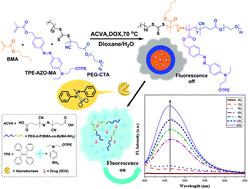当前位置:
X-MOL 学术
›
Polym. Chem.
›
论文详情
Our official English website, www.x-mol.net, welcomes your
feedback! (Note: you will need to create a separate account there.)
Azoreductase-triggered fluorescent nanoprobe synthesized by RAFT-mediated polymerization-induced self-assembly for drug release
Polymer Chemistry ( IF 4.1 ) Pub Date : 2020-07-31 , DOI: 10.1039/d0py00826e Yechun Zhou 1, 2, 3, 4, 5 , Zhe Wang 1, 2, 3, 4, 5 , Yuqing Wang 1, 2, 3, 4, 5 , Lishan Li 1, 2, 3, 4, 5 , Nianchen Zhou 1, 2, 3, 4, 5 , Yuanli Cai 1, 2, 3, 4, 5 , Zhengbiao Zhang 1, 2, 3, 4, 5 , Xiulin Zhu 1, 2, 3, 4, 5
Polymer Chemistry ( IF 4.1 ) Pub Date : 2020-07-31 , DOI: 10.1039/d0py00826e Yechun Zhou 1, 2, 3, 4, 5 , Zhe Wang 1, 2, 3, 4, 5 , Yuqing Wang 1, 2, 3, 4, 5 , Lishan Li 1, 2, 3, 4, 5 , Nianchen Zhou 1, 2, 3, 4, 5 , Yuanli Cai 1, 2, 3, 4, 5 , Zhengbiao Zhang 1, 2, 3, 4, 5 , Xiulin Zhu 1, 2, 3, 4, 5
Affiliation

|
Azobenzene-based polymeric nanoparticles have emerged as promising candidate for biological detection and controlled drug release in an anaerobic environment for colon disease treatment. Herein, we report a novel and efficient polymerization-induced self-assembly (PISA) strategy for fabricating polymeric nanovehicles to load drugs for triggered release and fluorescence detection based on a TPE (tetraphenylethylene)-azobenzene fluorescence probe sensitive to hypoxic microenvironments. In this study, a series of PISA-nanoparticles, including micelles and vesicles, were synthesized by reversible addition–fragmentation transfer (RAFT) dispersion copolymerization of monomers butyl methacrylate (BMA) and reductive-responsive TPE-AZO-MA (TPE-azobenzene derived methacrylate) in a 1,4-dioxane/water mixture. Subsequently, polymeric micelles loaded with doxorubicin (DOX) in situ were successfully obtained by PISA. Furthermore, the release and fluorescence change of PISA-formed micelles loaded with DOX were studied in a simulated colon environment under the action of azoreductase. As expected, the drug-loaded micelles showed an effective DOX release during enzyme hydrolysis within 24 h owing to azo bond cleavage. Meanwhile, significant fluorescence enhancement was observed, accompanied by the release process. This was due to the aggregation-induced emission (AIE) performance of TPE being efficiently activated by elimination of the fluorescence resonance energy transfer (FRET) process, also owing to azo bond cleavage. Finally, the cytotoxicity and cellular uptake of the blank micelles and DOX-loaded micelles in vitro were evaluated.
中文翻译:

RAFT介导的聚合诱导的药物自组装合成的偶氮还原酶触发的荧光纳米探针
基于偶氮苯的聚合物纳米颗粒已成为在结肠疾病治疗的厌氧环境中进行生物学检测和控制药物释放的有前途的候选对象。在本文中,我们报告了一种新型且有效的聚合诱导自组装(PISA)策略,该策略用于制造聚合物纳米车辆,以加载对低氧微环境敏感的TPE(四苯基乙烯)-偶氮苯荧光探针的药物,用于触发释放和荧光检测。在这项研究中,通过单体甲基丙烯酸丁酯(BMA)的可逆加成-断裂转移(RAFT)分散共聚和还原反应性TPE-AZO-MA(TPE-偶氮苯衍生1,4-二恶烷/水的混合物中加入甲基丙烯酸酯)。后来,通过PISA成功获得了原位。此外,在偶氮还原酶的作用下,在模拟的结肠环境中研究了负载有DOX的PISA形成的胶束的释放和荧光变化。如预期的那样,由于偶氮键的裂解,载有药物的胶束在24小时内的酶水解过程中显示出有效的DOX释放。同时,观察到显着的荧光增强,伴随着释放过程。这是由于TPE的聚集诱导发射(AIE)性能通过消除荧光共振能量转移(FRET)过程而得到有效激活,这也是由于偶氮键断裂所致。最后,将空白胶束和装载DOX的胶束的细胞毒性和细胞摄取在体外进行了评价。
更新日期:2020-09-16
中文翻译:

RAFT介导的聚合诱导的药物自组装合成的偶氮还原酶触发的荧光纳米探针
基于偶氮苯的聚合物纳米颗粒已成为在结肠疾病治疗的厌氧环境中进行生物学检测和控制药物释放的有前途的候选对象。在本文中,我们报告了一种新型且有效的聚合诱导自组装(PISA)策略,该策略用于制造聚合物纳米车辆,以加载对低氧微环境敏感的TPE(四苯基乙烯)-偶氮苯荧光探针的药物,用于触发释放和荧光检测。在这项研究中,通过单体甲基丙烯酸丁酯(BMA)的可逆加成-断裂转移(RAFT)分散共聚和还原反应性TPE-AZO-MA(TPE-偶氮苯衍生1,4-二恶烷/水的混合物中加入甲基丙烯酸酯)。后来,通过PISA成功获得了原位。此外,在偶氮还原酶的作用下,在模拟的结肠环境中研究了负载有DOX的PISA形成的胶束的释放和荧光变化。如预期的那样,由于偶氮键的裂解,载有药物的胶束在24小时内的酶水解过程中显示出有效的DOX释放。同时,观察到显着的荧光增强,伴随着释放过程。这是由于TPE的聚集诱导发射(AIE)性能通过消除荧光共振能量转移(FRET)过程而得到有效激活,这也是由于偶氮键断裂所致。最后,将空白胶束和装载DOX的胶束的细胞毒性和细胞摄取在体外进行了评价。











































 京公网安备 11010802027423号
京公网安备 11010802027423号